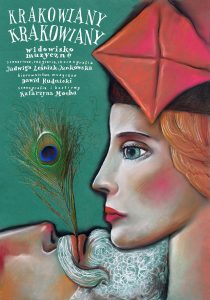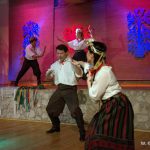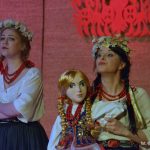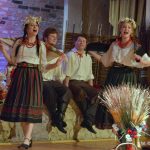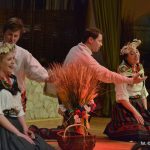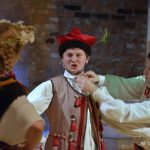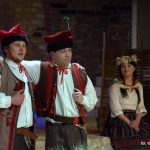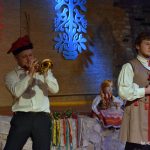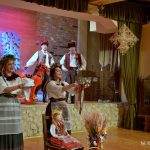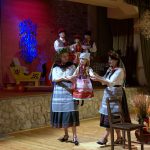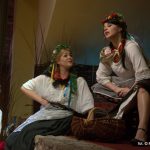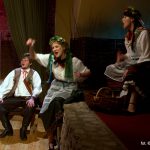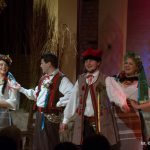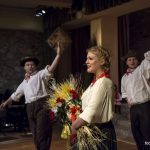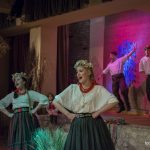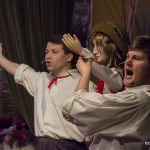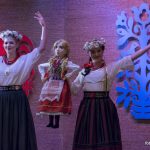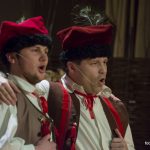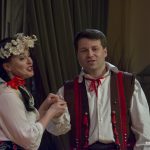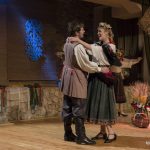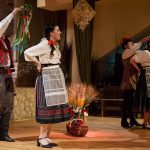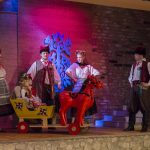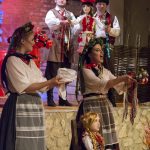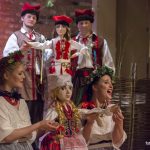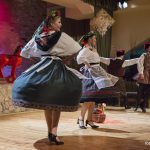Credits
Stage direction and choreoraphy – Jadwiga Leśniak-Jankowska
Musical direction – Dawid Sulej Rudnicki
Scenography and costumes – Katarzyna Mucha
Vocal – Monika Kołodziejska / Izabela Kubrak
Vocal – Anna Bugajska
Vocal – Marek Kaczmarczyk
Vocal – Maciej Rutkowski
Violin – Maria Boroń
Flute – Ewa Tupik
Clarinet, bass clarinet, soprano sax – Mariusz Stępień
Tube – Piotr Gawor / Michał Olearczyk
Percussion instruments – Jan Rusin
Keyboard instruments, trumpet, button zither, melodica – Dawid Sulej Rudnicki
Photos
fot. Paweł Zechenter
Reviews
‘Cracovians, Cracovians! Classy folklore in Krakow Chamber Opera’
Krakow Chamber Opera is celebrating its silver jubilee during the 2016/2017 artistic season. In the historic interiors of tenement building at Miodowa 15 numerous performances, concerts and spectacles take place. They are being orchestrated by two people with remarkable theatrical output: Jadwiga Leśniak-Jankowska – actress, choreographer and professor of AST National Academy of Theatre Arts in Kraków; and Wacław Jankowski, a theatre director.
‘Cracovians, Cracovians’
On 11th and 12th March premiere stagings of vaudeville ‘Cracovians, Cracovians’. The script of this colourful show was based on folk songs of Western and Eastern Cracovians. A rich collection of folk songs accumulated over many years by 19th c. Polish ethnographer Oskar Kolberg served as the main source of inspiration. Another important work of art which inspired this new show has been the music of Karol Kurpiński and Jan Stefani composed to a libretto of Wojciech Bogusławski and Jan Nepomucen Kamiński.
Love, wedding and festive songs as well as everyday, shepherd and harvest tunes are being performed live. In new, original and compelling musical arrangements they sounded truly spectacular. The production team took great care to create all the costumes and scenography. It was colourful and entertaining, at times even surprising (ingenious usage and animation of dolls representing the newlyweds). Stage movement has been precisely composed, producers also made sure to underline the beauty and character of the Cracovian dialect.
A big, well-deserved round -of applause should go to Jadwiga Leśniak-Jankowska for the script she prepared, directing the play and arrangment of the stage movement. Dawid Sulej Rudnicki, who was responsible for the musical arrangement, delivered an extraordinary work.
New arrangements of Cracovian folk songs sound amazing and are really catchy. Katarzyna Mucha has created charming, truly Cracovian costumes as well as projects for the dolls of Cracovian newlyweds.
The vocalists and actors – Anna Bugajska, Izabela Kubrak, Marek Kaczmarczyk and Maciej Rutkowski – did a magnificent job. The artists not only were brilliant in their performances of Cracovian folk songs, which are not that easy to handle; they have also displayed a keen understanding of traditional ceremonies by performing all the dances and scenes with ease.
The orchestra (Aleksandra Urban on violin, Ewa Tupik on flute and clarinet, Mariusz Stępień on bass clarinet and soprano saxophone, Piotr Gawor on tuba, Grzeforz Fieber on percussion, Dawid Sulej rudnicki on keyboards, trumpet, folk zipher and melodica), all dressed up in traditional dress with folk elements, was an integral part of the whole ensemble. They were very much active participants of the staging.
The stage show ‘Cracovians, Cracovians’ presented by Kraków Chamber Opera is an absolute must-see for people of all backgrounds and ages. It should be seen by senior, native citizens of Krakow, but even more so by teenagers who are becoming more and more detached from their roots. What is also noteworthy is that finally we have been given a spectacle that has a similar value for the tourists as Irish stepdance in Dublin or flamenco in Seville. Foreigners visiting Krakow will get the chance to spend an unforgettable evening absorbing the rich and vivid local folk tradition. The musical performance which lasts slightly over an hour shows the beauty of Krakow’s tradition and folk customs in a colourful, attractive fashion. The spectacle in which all of the elements (musical, visual and choreographic) interact with each other harmoniously weaves together into a beautiful, eye-catching tale. This story of Cracovian folk customs is almost a fairytale-come-to-life experience. We highly recommend you to visit Miodowa 15 and see it for yourself!
Anna Kańska-Małachowska
www.nascenie.info
13th March 2017
* * * * * * * *
‘Evenings filled with song – it was both amusing and touching’
On Saturday, March 11th, in Krakow Chamber Opera a musical spectacle entitled ‘Cracovians, Cracovians’ has been staged by Jadwiga Leśniak-Jankowska. The author has used the ethnographical works of Oskar Kolberg as an inspiration. By using those texts and melodies embellished by fragments of ‘The Presumed Miracle, or Cracovians and Highlanders’ by Bogusławski, Stefani and Kurpiński. The director created a tale about the Cracovians of old, villagers living in what are nowadays districts of Krakow. It is a tale of their joys and woes, of courtship, love, weddings and having a good time. As a director and a choreographer Leśniak-Jankowska conducted this play in a lively, graceful manner, adding a surprising turn of events every now and then.
Four young performers: Anna Bugajska, Izabela Kubrak, Marek Kaczmarczyk and Maciej Rutkowski sang and danced with such verve and joy that they resonated with the viewers. But the biggest advantage of this show, whose scenography has been prepared by Katarzyna Mucha, were the new arrangements of folk tunes made by Dawid Sulej Rudnicki. I must admit that when I first saw the musicians entering the stage with, among others, saxophone, tuba and elaborate percussion set, I was taken aback a bit. However, the arranger combined the slightly contemporary accompaniment with the folk singing so tastefully and with such a dose of humour that the whole thing sounded wonderful. Overall, Saturday evening at Miodowa proved to be really enjoyable.
Anna Woźniakowska
www.polskamuza.eu
13th March 2017
* * * * * * * *
‘Albośmy to jacy tacy?!’
After ‘Świtezianki’ (which employed old songs from former Polish Eastern borderlands) and ‘Chatskele, Chatskele!’ (which presented the Jewish traditional songs in Yiddish) Krakow Chamber Opera invited its spectators to participate in third part of the project ‘Academy of Tradition and Customs’. This time it was a folk music spectacle ‘Cracovians, Cracovians’. Its premiere coincided with the silver jubilee of the opera house. The performance has been scripted, directed and choreographed by Jadwiga Leśniak-Jankowska. The lyrics have been derived from a collection of Western and Eastern Cracovian folk songs by Oskar Kolberg, a preeminent Polish ethnographer.
Those are uniquely charming songs, since, as Kolberg himself put it, the people of Krakow region were ‘characterised by their poetic nature – undisturbed in their high spirits, boisterous in mirth, then again slightly melancholic”. And so it has been arranged: love and wedding, festive and everyday, shepherd and harvest songs are divided into seven scenes according to their content, just as Kolberg intended. They tell about those eternal dillemas of ars amandi: bodily attraction, wooing, budding romance, broken hearts, finally the joys of marital life (but also fears and anxieties connected with it). All of that served in a peasant setting which is both idyllic and husky, with all its specific customs and sense of both honor and humour. And yet there is something else that adds to the appeal of this stage play: the local dialect and the peculiar vocabulary. The most recognizable of those linguistic elements would surely be ‘bajok’ (‘idze idze bajoku’ – we would tell to a country-wise know-it-all), ‘klarnet’ (it has nothing to do with a musical intrument) or frequent use of a particle ‘-że, -żeż’ (‘-ze, -zez’) which is drawled at the end of the words. Both well-known Cracovian songs like ‘Krakowiaczek jeden’ and ‘Albośmy to jacy, tacy’ as well as lesser known, non-regional songs like ‘Oj chmielu, chmielu’ and ‘Lipka’ have been used in the production. What is more, the more artistic songs from vaudevilles ‘Cud mniemany, czyli Krakowiacy i Górale’ and ‘Zabobony, czyli Krakowiacy i Górale”’ as well as fragments from ‘Wesele’ by Stanisław Wyspiański have been employed. This unusual mix has been sanctioned by Kolberg himself when he observed how folklore and high-brow culture overlap and mutually influence each other. Later in his life he included arias of Stefani and Kurpiński in his volume on the folklore of Krakow region. Even though Kolberg has stated that he ‘deliver(s) this folk tune in its untainted simplicity, without any harmonic arrangment, because I am convinced that it is at it boldest in its natural, unspoiled purity’ we can assume that he wouldn’t be that unsympathetic towards the brilliant jazzy arrangments of Dawid Sulej Rudnicki.
The unusual set of intruments used included: fiddle, flute (which in the hands of Ewa Tupik was leading the melody most of the time), clarinets, soprano saxophone, tuba, percussion and keyborads, trumpet, folk zither and melodice (played by Rudnicki) was presenting the colourful array of songs in style.
The soloists (Anna Bugajska, Izabela Kubrak, Marek Kaczmarczyk, Maciej Rutkowski) were a real pleasure to listen to – the audience was captured by their varied vocal techniques, dancing skill and feistiness in songs and rhymed dialogues.
The high level of artistry in visuals has become a tradition for the Chamber Opera – this time Katarzyna Mucha took care of the red Cracovian hats, dark blue ‘kierezyje’ (peasant coats), floral wreaths and peacock feathers. Not only did she dress up the singers, but also the pair of dolls used in the spectacle.
„Cracovians, Cracovians” is a highly energetic stage show, full of colours and songs – not at all ‘so-so’ (‘jakie-takie’).
Monika Partyk
Ruch Muzyczny #5
2017 (May)
* * * * * * * *
Last Sunday in Krakow, in the Chamber Opera building on Miodowa St. the 2018 edition of Ars Cameralis fesstival has been inaugurated. Vaudeville ‘Cracovians, Cracovians’ by Jadwiga Leśniak-Jankowska has been chosen for the opening show. Its screenplay has been based on a collection of folk songs by Oskar Kolberg, a famous Polish ethnographer, the focal point being traditional folk songs of Western and Eastern Cracovians. The 70-minute spectacle made viewers familiar with the everyday life and culture of the inhabitants of villages that nowadays constitute the outer districts of Krakow. The show encapsulated most important events from the lives of our ancestors, like the harvest, feasts, courtship and weddings.
On a small stage four actors were presenting the range of their vocal and dancing abilities. Scenography has been sparse – a decorative bundle of hay, traditional Krakow cut-outs; ceiling decorations from hay and crepe paper, the so-called ‘spiders’; a cart pulled by two wooden horses, Costumes were also traditional, and that means richly decorated – corsets laced with sequins were glistening in the lights, girls’ heads were decorated with floral wreaths, peacock feathers attached to boys’ hats were bouncing to the rhythm, and the belts with metal ornaments were clinging with each move.
All those elements were enough to create an athmosphere faithful to the folk traditions and a perfect background for the most important part of the spectacle – the folk songs.
Special compliments should be given first of all to the actors – Monika Kołodziejska, Anna Bugajska, Marek Kaczmarczyk and Maciej Rutkowski. Their performance of the folks songs was spot-on – in their singing they told us about various stages of human life and accompanied themselves in everyday labour. Songs concerning love in its various forms were prevailing though – courtship and wedding are, after all, the happiest moments in one’s life. The jocular mode was balanced by more tender songs telling of a budding romance between young man and woman. Festive and shepherd songs were also the staple of the show.Everything as in good old days, but with a slightly modernized music and choreography at times.
Because it was a musical show, a folk band playing live music and singing along with the actors was a must. Right from the first notes the audience saw that they are up for jolly, lively music performed by young, enthusiastic artists lead by charismatic Dawid Sulej Rudnicki (who was also responsible for the coverage and musical management of the whole project).
After a big round of applause ended the joyous performance the official congratulations had been given and the festival was officially opened by the Head and Artistic Director of the Krakow Chamber Opera, Mr. Wacław Jankowski. He introduced all the artists who have reappeared on stage. Everything took place in a heartfelt, almost familiar athmosphere – in accordance with the joyous spirit of the folk songs which have just been performed. Now the Krakow operagoers are in for five consecutive Saturday performances, a varied repertoire which will surely meet with similarly warm welcome.
Aleksandra Cabaj
Kulturatka.pl
23th July 2018

